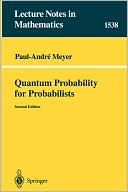

 |

|

The average rating for Quantum Probability For Probabilists based on 2 reviews is 3 stars.
Review # 1 was written on 2016-07-07 00:00:00 Stephanie Reichel Stephanie ReichelThis book is an attempt to explain quantum field theory with more interpretation and less calculational detail than in traditional physics texts. Even so, I found it awfully hard going. The author will give you a page or two of rather general philosophical discussion about the meaning of identity, and then WHAMMO, several pages of very complicated algebra full of not-so-common symbols, (like the commutator sign [a,b].) Most of the math was over my head, I admit. However, there are a bunch of things I do understand better, having read the book. I used to be terribly confused by the notion of virtual particles. Teller's explanation was beautifully clear, however: "When you calculate out the probability of an interaction with a QFT, you wind up with an infinite series, whose terms are ordered by how many raising and lowering operators there are. It's possible to interpret these operators as creation and annihilation of virtual particles, but they are no more real than the sine waves that make up a fourier decomposition." Given how ad-hoc and messy the math of QFT is, there is no particular reason to think our quirky weird way of writing equations is a precise description of how nature "really works". Likewise, his discussion of renormalization made reasonably clear sense. As I understand it, any field theory with point particles diverges when self-interaction terms are taken into account naively, but gives wrong answers when simply ignored. Renormalization involves splitting up the self-interaction terms into parts that are going to get ignored (or more precisely, cancelled out by the 'bare' mass or charge), and a part that scales with interaction energy, which is kept. And somehow this actually works out correct to nine significant figures. (!) I was more or less able to hang on through the book, but I can't recommend it to anybody who doesn't already have a pretty good grip on the basic concepts of quantum mechanics (including the mathematical representation in terms of operators), and linear algebra generally. But if you have the math and the background, there are good things in it. |
Review # 2 was written on 2010-01-06 00:00:00 David West David WestImagine if you wanted to learn about painting, but the only books out there were either glossy coffee-table books or technical manuals for mixing colors, choosing brushes, and drawing perspective lines. This has been the situation facing those of us interested in learning about the quantum world. On the one hand, there are popular-level books and magazine articles, which can be excellent but rely on analogies and metaphors; on the other, there are textbooks, which are geared toward physicists who intend to apply the theory and need to learn all the calculational tricks. This book plugs the gap. It is like a book on painting that gives you some details about how artists create works of beauty, but doesn't assume you actually want to be an artist yourself. Teller's book is mathematical and takes some effort to get through, but deepened my understanding of quantum physics in a way that no other book has done. Its main flaw is that it's now out of date, in particular on renormalization. For that, I recommend the latest edition of Tony Zee's "Quantum FIeld Theory in a Nutshell". |
CAN'T FIND WHAT YOU'RE LOOKING FOR? CLICK HERE!!!